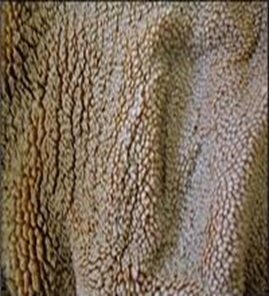Rumen has four compartments, and the rumen itself is 57% of all the compartments. In the baby calf, it is 30%. The second area is reticulum it is 57% of all the compartments. This is also called honeycomb area and also known as hardware area because cow eats wire or nail it is lodge in that area. In baby calf, it comprises 8% of all. The next area is omasum it is 25% of where and in baby calf it is 30%. It is here that water is absorbed and

In baby calf by eating grains butyric and acetic acid is produced which

Rumen Wall 
Honeycomb Reticulum Wall
The cow ruminates for 500 to 600 minute every day. Cow secrets 100 to 150 litres of saliva per day. The saliva maintains the pH of the rumen. After mastication, the cud is taken back in rumen.

The gases produced due to fermentation in the rumen (CO2 and H2) are also released during regurgitation. About 500 to 600 litres of gases are produced every day. If these gases are not released then there will be bloat. Release of gases is known as belching.
Rumen characteristics
- The pit of the rumen is 5.9 to 6.5 cm.
- The rumen contracts after 20-24 seconds
Rate of ingests is 6-9% per hour.
On rumen microbial fermentation, rumen gives a very pungent smell. It is because of the fibre is digested by the cellulase enzyme and glucose is fermented to give volatile fatty acids.
The volatile fatty acids are
- Acetic Acid – 60-75% gives energy.
- Prop ionic acid – 20 % glucose for lactose formation.
- Butyric Acid- 15%.
Acetic to propionic acid ratio should be 2:3, if the diet of the cow is only forged then acetic acid is 65% and propionic acid is 15%. If the diet of
In acidosis following happens
- pH is below 6.0.
- Volatile fatty acid production is low.
- Microbial population falls down.
- Laminitis, hoof problem.
- Milk production decreases.
- Fat in milk decreases.
- Animals fall sick.
- Subacute rumen acidosis cow is sick.
Fats are broken down into fatty acids, which does all fibre digestion. Vitamins are produced by microbs. Cow microbes produce biotin, niacin and thiamine.
Minerals are not degraded by rumen and absorbed in the intestine. Omasum is acetic but lower intestine is basic pH so pancreatic enzymes digest proteins, fats, and starch.
When protein is broken down ammonia is released. In cows, it is partially released in urine and mostly recycled through saliva in the rumen. In rumen due to microbial fermentation, it is converted into microbial protein.
Rumen Microbes
With an increasing population, we need food. Plant cellulose made by photosynthesis cannot be digested by humans, but cows can easily digest it. By its digestion, volatile fatty acids can produce fats and glucose. The bacteria also synthesize proteins. So, from glucose, we can get fats and proteins. You can enhance the process by providing non protein nitrogen, vitamins and good quality fodder.

It is a synthetic system for cow and microbes. Microbes are of the following type
- Bacteria – Volatile fatty acids, glucose and synthesises Protein 75% of bacteria produces and rest 25% are free.
- Protozoa (Degrades proteins and Metabolizes starch).
- Fungus (5-10% of the total microbes population, anaerobic fungi digests lignin only.
- By production of microbial formation is volatile fatty acid they provide 80% of total energy.
- Fibre microbial digestion produces Fats from acetic and Butyric acid and Grain microbial digestion produces l
actose by producing tropic acid.
If too
The saliva neutralizes the low pH due to the presence of bicarbonate. Addition of years also overcome. So, it is necessary to give sodium bicarbonate and bacterial culture to high yielding cows particularly in hot climate.

Sir My cow stop eating from last 4 Day..blood parasite is there and treatment is given by doctor..but still worried..can u pls guide what to do.weare worried